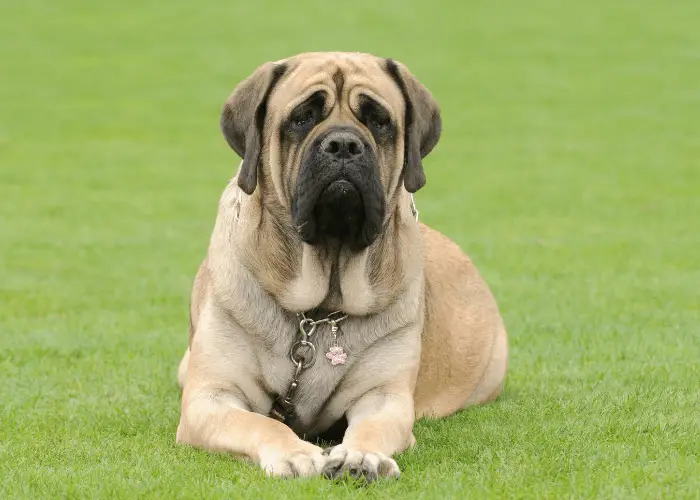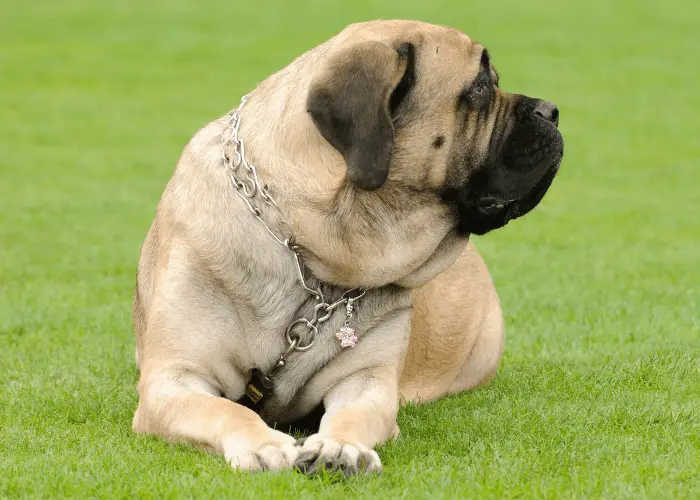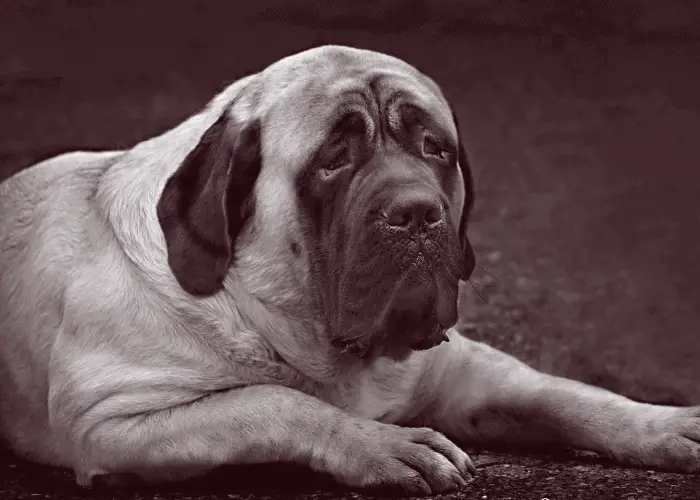Other Names: Mastiff, Old English Mastiff
Country Of Origin: England
Dog Group: Working
Size: Very large
Recommended For: Families, couples, single owners
Maintenance Level: Moderate
Lifespan: 7-9 years
Temperament: Friendly, affectionate, protective
FAQ

Good For First-Time Owner: No
Good With Children: Yes
Good With Other Animals: Yes
Good With Strangers: Sometimes
Good For Apartments: No
Exercise Requirements: Daily walking
Can Live In Hot Weather: Yes
Can Live In Cold Weather: Yes
Can Tolerate Being Left Alone: Yes
Grooming: Moderate
Trainability: Easy/moderate
Breed Overview

The English Mastiff is most well known for its size. The breed is very large, both in height and weight, which can be enough to put some potential owners off. However, Mastiffs are very loving dogs, and often behave like lap dogs regardless of their size!
The normal English Mastiff temperament is friendly and affectionate with their owners, but the breed can be wary around strangers. They make excellent guard dogs, but because of their size, owners should always be sure to train a Mastiff properly.
Color: Fawn or brindle
Height: Males – minimum 30 inches, Females – minimum 27.5 inches
Weight: Males – 150-250lbs, Females – 120-180lbs
[ Compare Persian Mastiff Breed ]Personality and Temperament

English Mastiffs are known for being very gentle and friendly, despite their size. While many might be intimidated by the sheer size of the breed, English Mastiffs aren’t known for being aggressive.
Conscious selective breeding has worked very hard to remove any negative traits from the breed.
For this reason, English Mastiffs make a good choice as a family dog.
That said, it’s best not to keep an English Mastiff around very small children, simply because of the breed’s size, but this is a decision most owners should be comfortable making for themselves.
English Mastiffs form very strong bonds with each family member, and are perfectly fine kept around older children.
On the other hand, Mastiffs can be very wary around strangers, particularly when at home.
They make good guard dogs, and it’s unlikely that even strict training will completely remove this wary tendency.
However, Mastiffs generally aren’t dangerous, and will usually only bark at strangers.
English Mastiffs are, however, usually fine around other animals.
Owners should be sure to socialize Mastiffs from a young age, mainly so the dog knows not to throw its weight around when playing.
Similarly, owners should always be careful around smaller dogs and other animals, again because of the breed’s size.
It’s also important for owners to ensure an English Mastiff is properly trained because almost any Mastiff will be much stronger than their owner.
This means that an untrained Mastiff could easily break away from its owner while out walking, which obviously isn’t ideal.
Owners should be firm and confident with their obedience training, and continue it throughout the dog’s life.
When it comes to exercise, English Mastiffs need daily walking. However, they don’t need as much exercise as you might think because they’re generally not an energetic breed.
A daily walk lasting between 30 minutes and an hour should be fine, along with some playtime for mental stimulation.
English Mastiffs definitely aren’t suitable for apartment living, for obvious reasons. The biggest is the breed’s size, which won’t make for a comfortable life in an apartment.
Similarly, Mastiffs do enjoy being outside, even if it’s just to lounge in the sun. The best home for an English Mastiff is one with plenty of land that the dog can use.
While English Mastiffs are a very sociable breed, they can be left alone while their owners are at work.
However, it’s important to establish a routine with the dog, and crate training will be useful for this.
Doing so will help the dog to understand that its owners are coming home, and this can do wonders to combat separation anxiety and depression.
English Mastiffs are generally fine to be kept in almost any climate, but owners should just be careful in particularly hot areas.
The breed has quite thick fur, and this, along with their size, can make it difficult for them to keep cool.
Owners should just be careful about when they exercise a Mastiff during summer months, and for how long.
Overall, English Mastiffs aren’t the best choice for first-time owners, simply because of their size.
A Mastiff needs a strong and confident owner because the only real control you can have over the dog is using commands.
An English Mastiff could easily overpower an inexperienced owner, and the breed will generally be aware of this and will take advantage if the chance comes up. First-time owners would be best to stick to a smaller breed that’s easier to control.
Grooming

English Mastiffs have a short, dense coat that’s pretty easy to care for. The breed is known for its black mask, but this generally doesn’t present on English Mastiff puppies, but comes in later in life.
Mastiffs shed all year round, but this increases during seasonal changes. Weekly brushing with either a soft brush or fine-tooth comb should do the job, but this should be increased to daily brushing during shedding seasons.
It’s important for owners to regularly check a Mastiff’s face wrinkles, and to clean around their eyes and nose with damp cotton wool every few days.
It’s really easy for food and debris to get trapped in the wrinkles, which can lead to a range of skin infections.
Owners should also be aware that English Mastiffs drool a lot.
It can be helpful to keep a cloth in your pocket while out walking, because if the dog shakes its head then you’re guaranteed to end up covered in dribble! There’s not much that can be done about this other than simply wiping it away.
English Mastiffs also need their ears checking every few days and cleaning roughly once a week, which will help avoid infection.
Owners should also trim the dog’s nails regularly, and brush their teeth every few days to avoid dental problems.
Common Diseases and Conditions

English Mastiffs have a number of health complications related to their size. For starters, the dog shouldn’t run excessively for the first 2 years of its life, as this can damage its growth plates.
Mastiffs grow very fast, and can put on 5lbs in weight in a single week! Therefore, owners need to provide the right diet and make accommodations for this growth rate.
For example, a Mastiff should always be given a soft surface to sleep on, which will help to minimize the risk of arthritis and inflammation.
Mastiffs are also prone to common purebred conditions, such as hip and elbow dysplasia, which are made worse by its size.
Another big problem is gastric torsion, which is a twist in the gut. This can be avoided by feeding the dog several smaller meals each day instead of fewer large ones.
History

It’s believed that the English Mastiff can trace its lineage all the way back to the 6th century BC, as sculptures have been found of war dogs that look very similar.
These dogs were almost identical to the war dogs used by the Roman army, which is how they spread throughout Europe.
One of the main ancestors of the Mastiff is the Pugnaces Britanniae, which was a hunting and fighting dog found in Britain during the Roman conquest.
Historical sources claim that these dogs were exported across Europe during the 11th century, showing they were already a desirable working dog.
English Mastiffs were commonly used for a variety of roles, including herding, fighting, cart pulling, and dog and bull fights.
After the 1835 Cruelty to Animals Act, new Mastiffs were bred to be guard dogs, and these were much less aggressive than their ancestors.
Such a wide and long use meant the breed had few definable standards, although this changed in the late 19th century as breeders attempted to develop a consistent Mastiff dog that incorporated the most desirable characteristics.
Although Mastiffs were imported to America in the 19th century, but WW1 the breed was essentially extinct outside of the UK.
However, a Mastiff was registered in Canada in 1918, which marked the eventual rise in popularity of the breed again.
Since WW2, when breeding essentially stopped, Mastiffs have become a popular dog across the world, and are mostly kept as companion pets, although some do still fulfill working roles.
Did You Know?
- An English Mastiff holds the record for longest and heaviest dog in the world. Zorba measured 37 inches high and weighed 343lbs when fully grown!
- Although the actual price of an English Mastiff isn’t that high, owners can expect to pay plenty in food bills! English Mastiffs specifically weren’t bred during the World Wars because of how much food they eat.
- The English Mastiff is one of the best-known types of Mastiff. In fact, all others basically descend from this breed.
- It’s believed that the first Mastiff to make it to America came over on the Mayflower. Colonists had both a Mastiff and a Spaniel, but proper importation didn’t start until the 1800s.
- Mastiffs grow quickly but take a long time to mature. Unlike many other breeds, they’re not considered adults until they reach 3 years of age.
You’ll find more British Dog Breeds in the links below:


